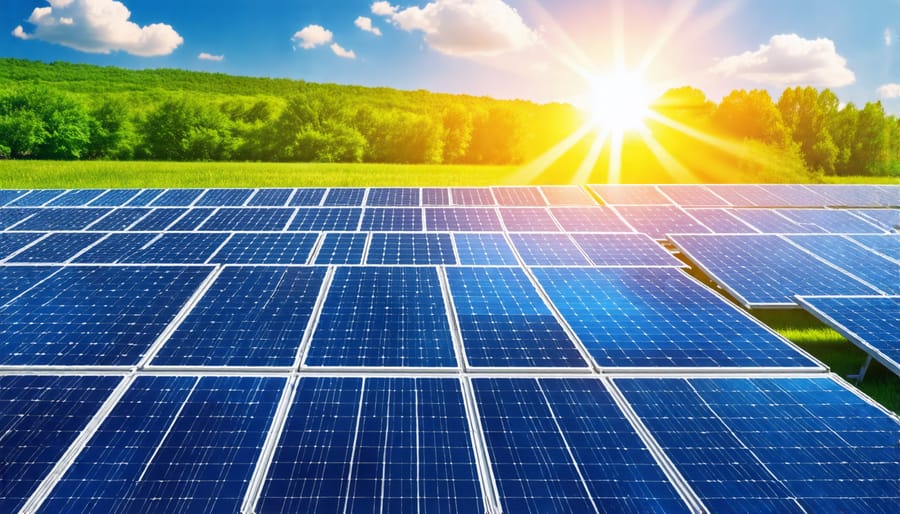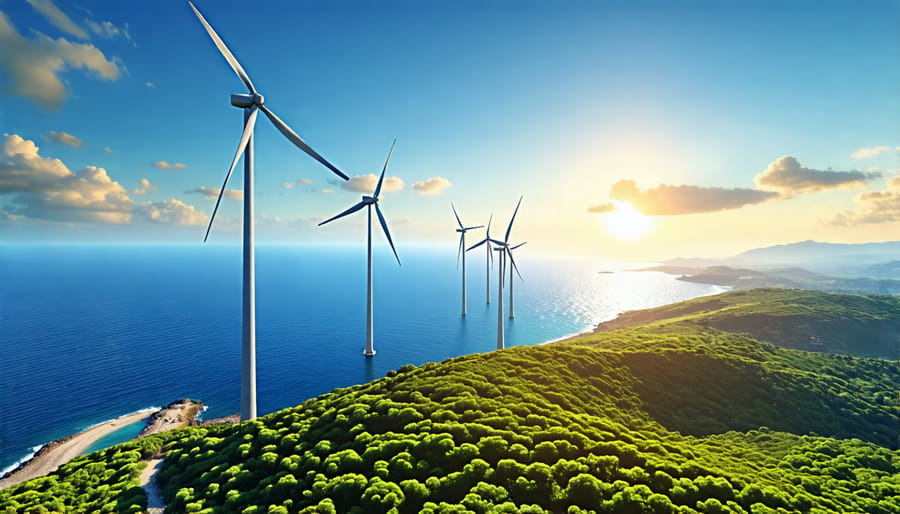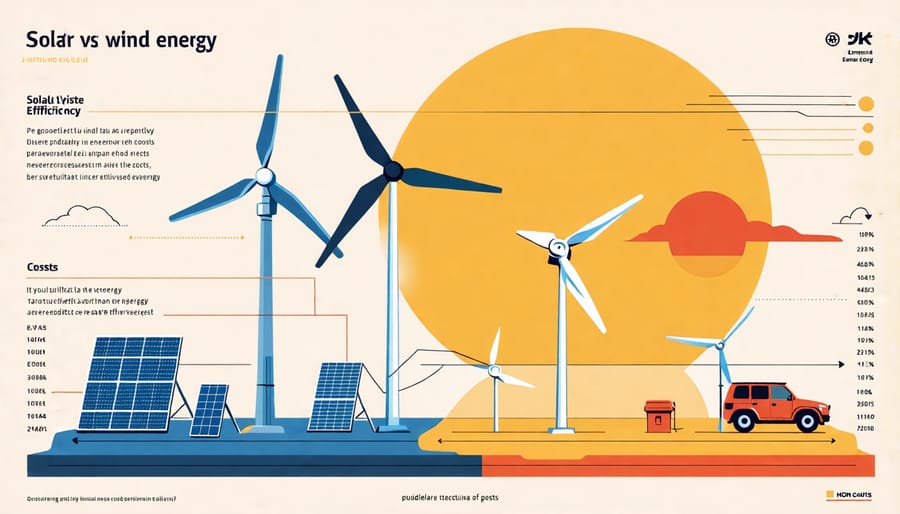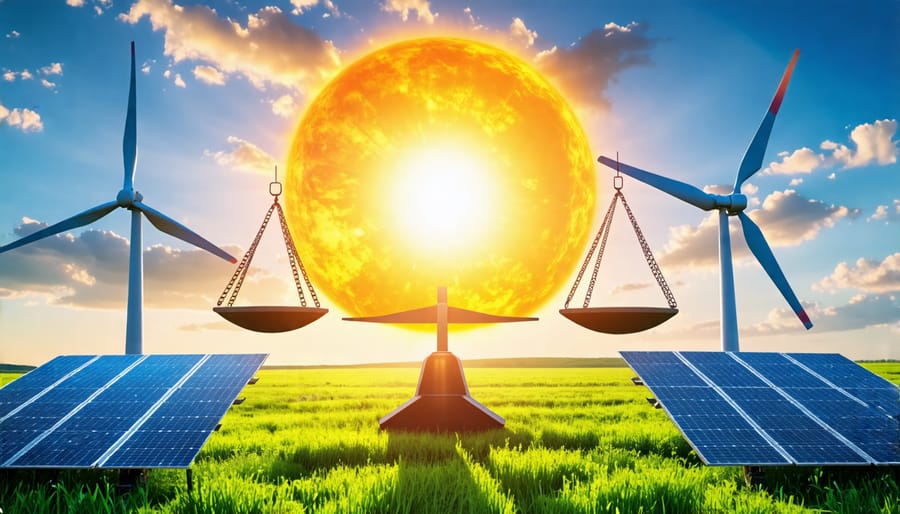Evaluate energy needs and geographical constraints to determine whether solar or wind energy suits your scenario better. Compare solar energy’s efficiency in sunny regions versus wind energy’s effectiveness in areas with consistent wind patterns. Analyze the cost-effectiveness of installation and maintenance for each system, considering long-term savings and incentives. Assess the sustainability impacts, prioritizing options that minimize environmental disruption and support community goals.
Understanding Solar Energy

How Solar Panels Work
Solar panels operate through a fascinating process known as photovoltaics, which allows them to convert sunlight directly into electricity. At the heart of this technology are photovoltaic cells, primarily made of silicon, organized into solar panels. When sunlight hits these cells, it energizes electrons, causing them to flow and generate an electric current. This process begins with the absorption of sunlight by the photovoltaic cells, which contain semiconductor materials that release electrons upon exposure to light. The movement of these electrons establishes a direct current (DC) flow. For practical use in homes and businesses, this DC is then converted into alternating current (AC) using an inverter, aligning it with the grid’s electrical standards. The beauty of solar panels lies in their ability to harness a free and abundant natural resource, offering a clean, sustainable energy solution without the emissions associated with fossil fuels. With ongoing advancements, solar technology continues to become more efficient and accessible, playing a crucial role in the transition to renewable energy sources.
Applications of Solar Energy
Solar energy is a versatile power source utilized in various settings, bringing sustainability and efficiency to the forefront. In residential areas, solar panels are increasingly common, offering homeowners an opportunity to significantly reduce electricity bills while minimizing their carbon footprint. These systems can support essential functions such as heating water, supplying electricity, and even powering entire homes through a smart grid connection. Commercial enterprises, too, leverage solar power to drive down operational costs and meet corporate sustainability targets. Retail chains and office buildings integrate rooftop solar installations to harness clean energy, achieving significant cost savings over time and enhancing their brand image as eco-friendly establishments.
Industrial applications showcase solar energy’s ability to support more extensive energy needs. Factories and large facilities often employ solar to offset a portion of their hefty energy consumption, which helps in stabilizing energy costs and complying with environmental regulations. Innovative developments continue to emerge, such as solar-powered manufacturing plants and agriculture projects utilizing solar irrigation systems to sustain crop yields. As technology advances, the potential applications of solar energy will likely expand, unlocking more opportunities for integration across different sectors.
Exploring Wind Energy

How Wind Turbines Work
Harnessing the power of the wind, wind turbines stand as towering symbols of sustainable energy. These remarkable machines convert kinetic energy from wind into electricity through a marvel of engineering. As the wind spins the turbine’s blades, they drive a central rotor connected to a shaft. This shaft spins a generator, producing electrical power. The process begins when the blades, designed to capture even the slightest breeze, start rotating. Mounted atop tall towers, wind turbines take advantage of higher wind speeds found at greater altitudes.
Modern turbines are equipped with sensors to adjust the blades’ angle, optimizing performance in varying wind conditions. This adaptability, combined with the nearly limitless supply of wind, underscores their efficiency and environmental benefits. Wind power is clean and does not emit greenhouse gases once established, making it an attractive option for those seeking to reduce carbon footprints. While initial investments can be significant, maintenance costs are relatively low, and advances in technology continue to drive improved energy outputs, bolstering the case for wind energy in our pursuit of sustainable power solutions.
Uses and Benefits of Wind Energy
Wind energy is harnessed through wind turbines, which convert kinetic energy into electricity, offering a sustainable power solution across various sectors. In the residential sector, wind energy reduces dependency on fossil fuels, allowing homeowners to lower energy bills and minimize their carbon footprint. Commercial enterprises benefit from wind power by achieving energy independence, strengthening their public image as eco-friendly organizations. On a larger scale, wind farms are pivotal in providing electricity to national grids, mitigating the environmental impact of traditional energy sources.
Environmentally, wind energy stands out due to its minimal carbon emissions during operation. Unlike conventional energy sources, it doesn’t emit greenhouse gases or air pollutants, significantly combating climate change. Additionally, by conserving land, especially through offshore installations, wind farms coexist with other land uses like agriculture. In Denmark, where wind energy supplies over 40% of electricity, this approach has revolutionized how nations can balance energy needs with environmental stewardship, illustrating that with strategic implementation, its advantages can match, if not exceed, those of solar energy.
Comparative Analysis: Solar vs. Wind

Efficiency and Output
When comparing the efficiency and output of solar and wind energy, both possess unique advantages tailored to specific environments. Solar panels convert sunlight into electricity with an average efficiency of 15-20%, and advancements in technology are continuously driving these numbers upward. Their energy output is maximized in regions with consistent sunlight, such as deserts, making them ideal for urban settings and individual households.
On the other hand, wind turbines boast a higher efficiency rate, often between 35-45%. They perform exceptionally well in coastal and elevated areas where wind speeds are steady. However, the output from wind energy can be sporadic due to its dependency on wind conditions, sporadically surpassing expectations during windy seasons or plummeting during calmer periods.
Both energy sources thus cater to different needs. Solar energy offers predictable energy production during daylight, while wind energy can provide substantial power output when conditions are favorable. Choosing between them depends largely on regional climate conditions and specific energy requirements, ensuring each technology fulfills the promise of a sustainable future effectively.
Cost Considerations
When considering the cost of solar versus wind energy, several factors come into play, such as initial investment, maintenance expenses, and long-term savings. Solar energy systems typically involve an upfront cost for purchasing and installing photovoltaic panels, which can range from moderate to high depending on the size and capacity of the system. However, their maintenance is relatively low, primarily requiring occasional cleaning and inspections. Wind energy, on the other hand, demands a higher initial outlay, especially for large-scale turbines, though they can harness more energy per unit in optimal conditions.
Both energy sources offer considerable long-term savings by reducing or even eliminating electricity bills. Solar panels can produce energy efficiently in sunny climates, while wind turbines excel in windy areas. Over their lifespan, both technologies yield a return on investment through energy independence and reduced reliance on fossil fuels. Real-life case studies, such as community projects switching to solar in sunny states or wind farms in coastal regions, illustrate these economic benefits and the potential for significant cost savings in the long run.
Sustainability and Environmental Impact
When considering the environmental impact of solar and wind energy, both strive to reduce carbon emissions significantly when compared to fossil fuels. Solar panels have a relatively low carbon footprint, primarily during manufacturing and installation, but once operational, they produce virtually zero emissions. Wind turbines also offer a clean energy source with minimal emissions during their lifecycle. Both power sources are instrumental in combating climate change by reducing reliance on carbon-intensive energy.
However, each comes with unique ecological considerations. Solar farms, if not properly sited, can disrupt local ecosystems and agricultural land. Conversely, wind turbines have been linked to bird and bat fatalities, although innovative solutions are emerging to mitigate these issues. Engaging stories like “Feathered Fatalities,” explore these challenges further.
Despite these challenges, the potential for renewable energy sources like solar and wind to provide sustainable, optimistically robust solutions remains unchallenged. By carefully managing their environmental impacts, these technologies can significantly contribute to a greener future, catering to an audience eager for sustainable energy solutions.
Real-life Case Studies
Pioneering Solar Projects
Around the globe, solar energy projects are setting new benchmarks for sustainable power. The Tengger Desert Solar Park in China, often referred to as the “Great Wall of Solar,” spans an impressive 43 square kilometers and generates over 1,500 megawatts—enough to power hundreds of thousands of homes. India’s Bhadla Solar Park, the world’s largest, boasts a capacity of more than 2,245 megawatts. In California, the Ivanpah Solar Electric Generating System innovates with advanced solar thermal technology, providing clean energy while minimizing environmental impact. These pioneering projects underscore solar energy’s potential to supply large-scale, sustainable power solutions globally.
Innovative Wind Deployments
Revolutionary wind projects are transforming the renewable energy landscape. Perhaps one of the most significant is the Hornsea Project in the North Sea. This groundbreaking endeavor, with its world-record scale, promises to power over a million homes, demonstrating wind energy’s potential. Innovations like floating wind turbines are overcoming geographical limitations, allowing installations in deeper waters where winds are stronger and more consistent. Meanwhile, small-scale urban wind solutions are making waves in city environments, integrating seamlessly into buildings to provide local energy generation. These initiatives illustrate wind energy’s adaptability and growth, capturing the imagination of those committed to a sustainable future.
Expert Opinions
Technology Trends
As we look to the future of sustainable energy, exciting advancements in technology promise to enhance the efficiency and accessibility of both solar and wind energy. Emerging technologies, such as transparent solar panels and perovskite solar cells, are pushing the boundaries of what’s possible with solar energy. Transparent panels offer the potential to turn windows in homes and skyscrapers into energy-generating surfaces. Meanwhile, perovskite cells, known for their high efficiency and low manufacturing costs, are being integrated into flexible and lightweight solar products, making solar power more versatile than ever. On the wind energy front, floating wind farms are gaining traction, unlocking vast wind resources in deep-water areas previously inaccessible. These innovations showcase the incredible potential of harnessing wind energy. To stay updated on further advancements, explore the latest innovations in wind energy. As these technologies evolve, they ensure a promising future for renewables, offering environmentally conscious solutions that could transform how we power our lives.
Policy and Market Dynamics
Policy decisions play a pivotal role in steering the trajectory of solar and wind energy. In recent years, government incentives and subsidies have driven significant growth in both sectors, encouraging investment and innovation. For instance, tax credits and rebates have made solar panels more accessible to everyday consumers, while renewable portfolio standards have mandated utilities to integrate more wind energy into their grids. Market trends also reveal an optimistic future, with both solar and wind experiencing decreasing costs and increasing deployment. Technological advancements in battery storage and grid integration are enhancing the reliability of these renewable sources, making them more competitive with traditional fossil fuels.
However, the dynamics between these energy sources differ depending on regional characteristics. In areas with abundant sunlight, such as Arizona or New South Wales, solar energy thrives, bolstered by favorable policies. Conversely, wind energy is advantageous in regions with consistent wind patterns, like the Plains in the United States or coastal regions in Europe. As policymakers continue to recognize the urgency of addressing climate change, tailored strategies that consider these local advantages are likely to emerge, making the future of solar and wind energy not just a matter of preference, but of practical suitability.
Conclusion
As we’ve explored in the article, both solar and wind energy present promising paths for sustainable energy solutions. Solar energy excels in environments with high levels of sunlight and is particularly well-suited for decentralized energy systems in residential and small-scale applications. On the other hand, wind energy shines in areas with consistent and strong wind currents, making it highly effective for large-scale electricity generation, often feeding directly into the grid.
Real-life case studies and expert interviews have highlighted that the choice between solar and wind isn’t necessarily one of competition but rather complementarity. For instance, while solar energy can provide a stable supply during daylight hours, wind energy often contributes more power at night or during cloudy periods. Both technologies have seen significant cost reductions in recent years, making them increasingly accessible and competitive compared to traditional fossil fuels.
While the debate between solar and wind might continue in terms of efficiency and specific applications, there is little doubt about the benefits of renewable energy adoption overall. Embracing a mix of renewable sources tailored to specific geographic and economic contexts is the key to achieving energy sustainability. With ongoing technological advancements and supportive policies, the future of renewable energy looks bright, offering hope for a greener, more resilient energy landscape.





